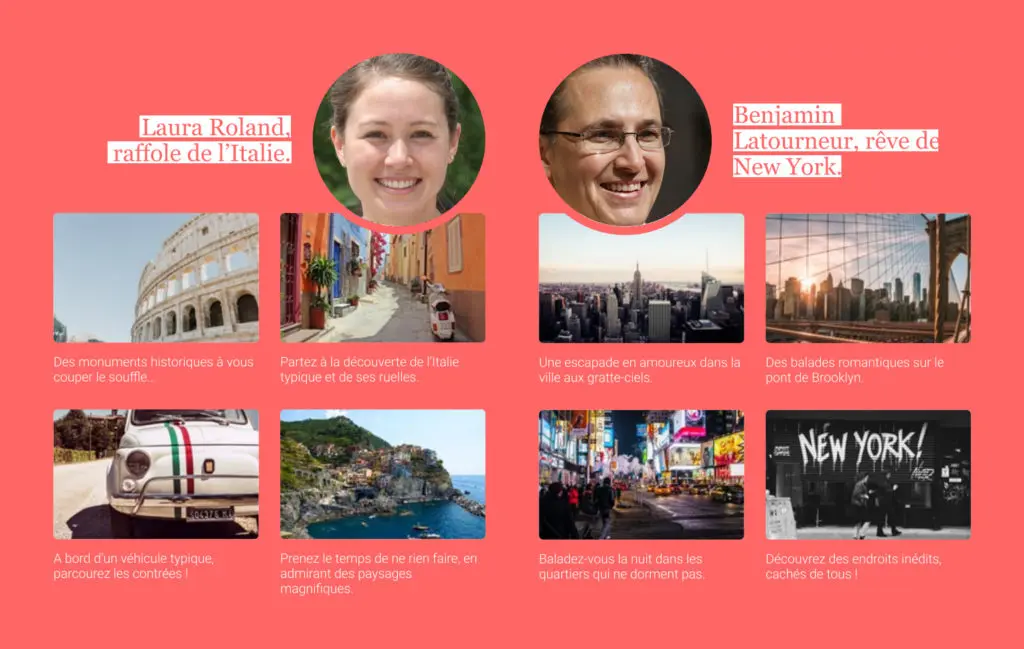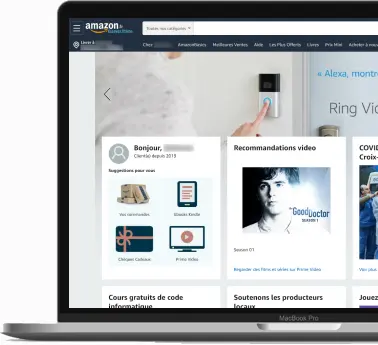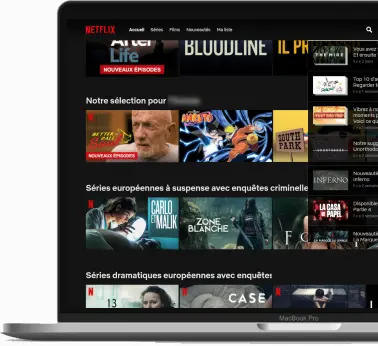Table of contents
A new digital landscape
Ask a marketer what their main goal is and they will say: offer a more personalized experience to its customers. It's not just strategic intent to increase conversion ratesand to meet growing customer expectations.
Let's put it in context. Five years ago, it seemed unbelievable that Amazon could recommend us a product that we would have chosen. Today, it seems normal that Netflix would recommend a new series based on our tastes. In reality, almost 74 % of users are disappointed with websites that do not offer personalized content. ?
74 % of online consumers say they are frustrated by websites where the content offered (offers, ads, promotions...) is irrelevant to their interests.Online Personal Experience Study, Janrain
So how do you meet this growing demand for personalized communications? First, by realizing the power of dynamic content and understanding that it makes static content obsolete.
If the dynamic content is well exploited, communications are not perceived as automatically generated, but as totally natural and personalized. This solution does not have to be expensive: it is sometimes accessible even to small companies. So here's how to incorporate dynamic content into your marketing strategy.
When discovering a new technology, learning the methods, features and implementation can be a deterrent. Not for dynamic content. This guide will walk you through the ins and outs of dynamic content and show you 7 ways to start integrating it into your marketing strategy today.
What is dynamic content?
To put it simply, dynamic content refers to the elements of a website or an e-mailing that change according to the information known about the user or his previous behavior.
For example in an e-mailing, the main banner may vary and display a picture of a beautiful travel destination for a user looking to book a vacation. An offer displayed on a web page can be different for a first time visitor and for a high scoring prospect who is probably ready to buy. Another example: a clothing retailer may display a banner ad for a pair of jeans similar to the one the user purchased on the site the week before.

In a word, dynamic content creates a personalized experience for each individual user. ? So, rather than everyone who visits your site or receives an email from you seeing the same thing, your prospects may see different content depending on how they interacted with you before.
Examples of dynamic content
The future of marketing lies in database marketing, which allows us to know enough about each customer to provide them with individually tailored and relevant offers.Philip Kotler
To illustrate our point, let's look at some concrete examples of dynamic content. It's very simple: almost every major company in the world uses dynamic content, to a greater or lesser extent.
Amazon

Ah, Amazon. Whether you like or dislike this retail giant, it is a forerunner in the use of dynamic content. You see those product suggestions that appear on the site or when you click on an item that interests you?
It is not an army of private detectives employed by Amazon to detect the interests of the hundreds of millions of users of the site: is simply what we call dynamic content.
Netflix

Online retailers aren't the only ones using dynamic content. Netflix also tracks what content you watch and for how long, to make you personalized recommendations on programs that may be of interest to you. So when you log in to your Netflix profile, the content that is displayed is completely different from that offered on your spouse's or other family members' profile.
It would be surprising if the most visited website in the world did not use dynamic content. Google does this in a number of ways. One of the most common is searching for a service or store around you, which Google responds to by providing personalized content based on your geographic location. So someone searching for a coffee shop in Chicago and someone searching for the same thing in Seattle will be presented with completely different results.
Other telling examples
Almost all major players in the industry make good use of dynamic content to personalize the buyer's journey and provide a better user experience.
Using dynamic geolocation, Domino's Pizza can show the user the nearest store based on their location. Hilton hotels can offer different deals depending on the user's travel schedule.
Using purchase history is also a way to leverage dynamic content.
The e-learning platform Udemy recommends courses based on the user's purchase history, and YouTube offers a constantly updated list of recommendations based on the history of content viewed.
FitBit studies your profile (diet, exercise, sleep, weight) according to the objectives you entered when you registered, then sends you regular emails related to your goals throughout the day.
How does dynamic content work?
For 94 % of in-house marketers, website personalization is essential to the success of the site, now and in the future.The Realities of Online Personalization, Econsultancy
The way dynamic content works is easy to understand, its implementation can be more complex if you don't have the right tools. Fortunately, the marketing automation platforms (marketing automation platforms) allow you to offer personalized content to your users easilyfor example via an interface that allows you to point and click to change the options, without having to type a line of code.
Dynamic content works on a simple principle: once you have collected data about your users (name, location, pages visited, purchases made etc.)You can use this data to change the content that appears on your homepages or in your e-mailings to target individual users.
For example, a customer goes to an online sales site, consults different products, makes a choice, enters his contact information (name, address etc.) in the order form and purchases the product. His contact information, the product he purchased and the products he consulted constitute data relevant to this user, which are stored in his prospect file. The next time this customer visits this online store, the site will recognize him, access his stored data, and offer him products similar to his previous purchases.
To provide dynamic content to users, several elements are required.
A central marketing database
Data must be collected and stored in a marketing database. Each user is assigned a unique ID, and each interaction with the site is stored in the database.
A dynamic content generator
There must be a way to retrieve the information collected in the database, to display it on the page or in the e-mailing. A dynamic content generator can display this information in the form of a number of elements and automatically show or hide elements according to the available data.
An integrated e-mailing system
To carry out personalized campaigns, your e-mailing system must be integrated with your database.
An editable home page
In order for the dynamic content generator to work, the web page must be built in a malleable way. This allows both for dynamic content code to be placed on the site where it is needed, and for better future personalization based on user data collected.
7 ways to use dynamic content
The objective of marketing is to know and understand the customer so well that the product or service offered is perfectly suited to him and sells itself.Peter Drucker
The examples at the beginning of this guide illustrate the many ways to integrate dynamic content into your marketing strategy. Here are 7 examples among others, but don't limit yourself to these solutions: test other options yourself. The most important thing to keep in mind is to always make sure that the content you offer is relevant to the user.
1. Home pages
Landing pages are a great way to convert users into customers. Consider the impact of a personalized message for each user. The detail of the content depends on the product, of course. Start by incorporating the prospect's name into the page design, then reference products the user has used in the past. You can go even further by personalizing the call to action. For example, if the prospect has already taken advantage of one of the rewards offered upon subscription, display another reward to keep them in your sales channel.
2. E-mailings
Using dynamic content in your e-mail campaigns is a great way to increase your open and conversion rates. You can do much more than integrate the user's name to personalize an e-mailing. The content can be tailored to the user's location or visit history, just like the landing pages.
3. Forms
Dynamic content provides a better user experience by offering personalized forms. Unlike an unidentified visitor, when a visitor is recognized the site can present variations on the forms, or make elements disappear. For example, an unidentified visitor may see a form with a special offer, while a known visitor simply needs to confirm their email address. Other personalization elements may appear when a visitor is recognized, such as a login page instead of a registration page.
4. Redirections
It is also possible to convert users into customers through redirects. For example, if a user has searched for information about Hawaii, they may be redirected to a page featuring Maui. Redirects can happen almost instantly, without the user even realizing they have been redirected.
Globally, companies are investing in implementing personalization initiatives, solving user challenges and creating digital experience platforms.Digital Experience Technology & Delivery Priorities, Forrester
5. Pop-ups
Dynamic content can also be offered without necessarily relying on the user's history. Based only on real-time indicators (time spent on a page, duration of inactivity, scrolled pages or menus, clicked elements...)For example, you can create smart pop-ups that target a specific action. Generally, this technique is useful to prevent a visitor from leaving the site without going through your sales channel first. This type of dynamic content allows you to direct the visitor to the most appropriate content according to his geographical location.
6. Personalized recommendations
We've talked before about how big online companies are using personalized recommendations. Amazon and Netflix make recommendations based on collected data, to get their users to buy more items (in the case of Amazon) or to continue their subscription (in the case of Netflix). But recommendations are not always directly related to products. You can also recommend content from your blog based on what the user has already viewed. This "frees up" content from the usual shopping scope, and ensures that users see the most products.
7. Dynamic searches
On large sites with hundreds of thousands of pages, search bars can easily be made easy to use: use individual user data along with the site data as a whole to provide a user-friendly and personalized experience. One way to do this is to suggest the most frequent searches. In addition or alternatively, the site can suggest results based on the user's previous preferences. For example, a user may show a preference for a particular brand of clothing, or only purchase items within a certain price range.
Now it's personal...
If your company has so far refrained from using dynamic content, now is the time to rectify this. Put personalization at the top of your strategic planning and start delivering the user experience customers expect, thanks to dynamic content.